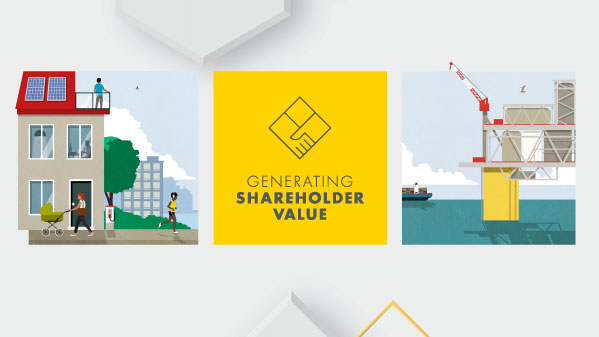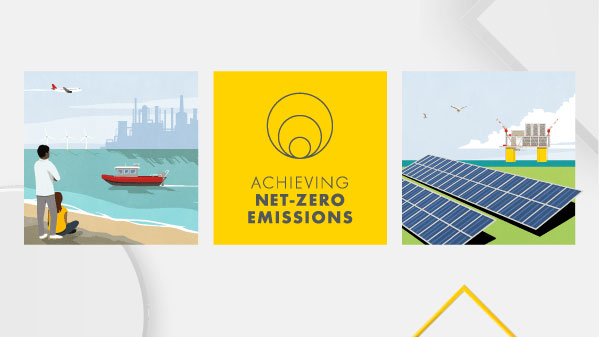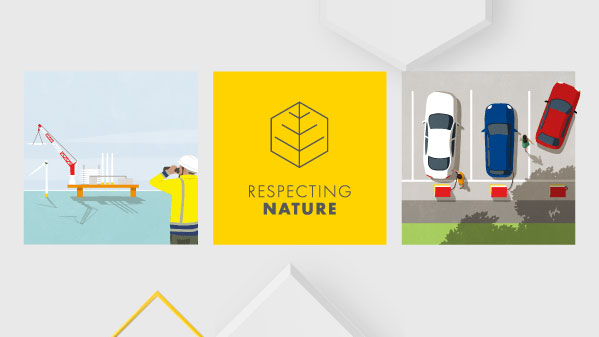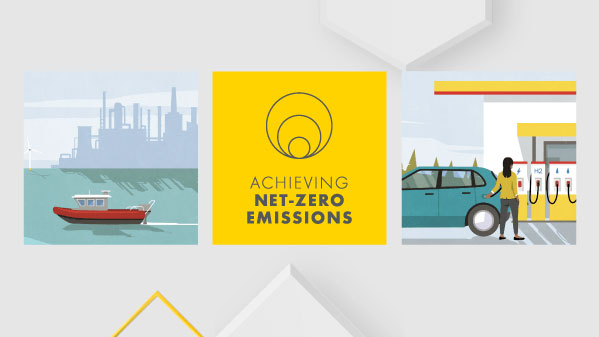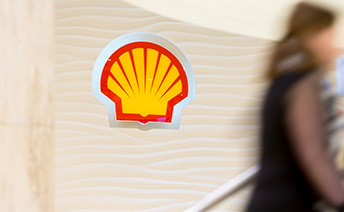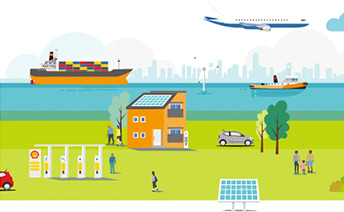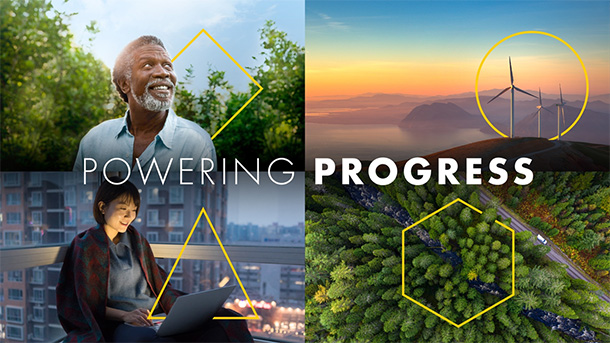Respecting nature
We recognise there is a growing urgency to protect and enhance biodiversity, preserve water quality and availability, improve air quality and use resources more efficiently. Nature loss and climate change are interconnected and need to be tackled together, as recognised at COP27 and COP15.
Respecting the environment has been an integral part of the way we do business for many years, as set out in the Shell General Business Principles and Shell Commitment and Policy on HSSE & SP. Respecting Nature is one of four pillars of our Powering Progress strategy, which we launched in 2021. Our commitments focus on four priority areas: biodiversity (land and marine environments), water, circular economy and waste, and air quality. They set out our ambitions for 2030 and later, as well as shorter-term goals.
We have included our commitments in our performance management and reporting systems and have been working to define baselines and track progress. Our Executive Committee is accountable for delivery of the Respecting Nature goal.
We have made a commitment to include requirements in our purchasing policies that reflect our environmental framework and take the energy efficiency, material efficiency and sustainability of products into consideration in our purchases.
We will continue to seek opportunities to go further. Our environmental ambitions are underpinned by collaboration with our supply chains and transparent reporting.
Environmental standards
Shell´s global environmental standards are set out in our HSSE & SP Control Framework and we seek to apply them wherever we operate. Our approach draws on external standards and guidelines, such as those developed by the World Bank and the International Finance Corporation. Our environmental standards include details of how to manage emissions of greenhouse gases (GHG); consume energy more efficiently; reduce gas flaring and monitor and improve air quality; prevent spills and leaks of hazardous materials; use less fresh water; and conserve biodiversity.
When planning new major projects, we conduct detailed environmental, social and health impact assessments. The Shell HSSE & SP Standards require that we certify our major installations against an internationally recognised independent environmental management system standard if they have significant environmental risks. Major installations are crude oil and natural gas terminals; gas plants; manned offshore and onshore production platforms or flow stations; floating production and storage vessels; refineries; chemicals manufacturing facilities; mines; or upgraders. For the purpose of this Report, we did not count each major installation in Upstream and Integrated Gas separately. They were aggregated into their respective operating unit or operating company, such as Shell Upstream UK or Nederlandse Aardolie Maatschappij (NAM), in line with the scope of their certifications. At the end of 2022, 100% of major installations within that scope and operated by Shell were certified against the ISO 14001:2015 Environmental Management System or were in compliance with equivalent environmental frameworks required by local regulations. In addition, many installations that are not classified as major, such as lubricant plants or supply terminals, are also certified against ISO 14001 but are not included in the data above.
See also “Control Framework” and “Our journey to net zero” for more information on how we manage our GHG emissions.
Biodiversity
We aim to minimise the impact of our onshore and offshore projects on biodiversity and ecosystems, whether life on land or life below water.
Since 2021, all projects in critical habitats and nature-based solutions projects must have measures in place to achieve a net-positive biodiversity result. If we decide to go ahead with a project that is in a critical habitat, we develop a biodiversity action plan. This includes applying the mitigation hierarchy, a decision-making framework that involves a sequence of four key actions: avoid, minimise, restore and offset. We assess the potential impact of projects on biodiversity as part of our impact assessment process. If there is an impact on biodiversity, the plan outlines the actions required to help achieve a net-positive outcome for biodiversity. For example, in our recently announced Jackdaw project in the UK, our impact assessment determined there were no significant environmental or socio-economic impacts identified after implementation of mitigation measures.
Our commitments include replanting forests, achieving net-zero deforestation from new activities, while maintaining biodiversity and conservation value. Deforestation occurs when forests are converted to non-forest uses. We use the definition of forest used by the Food and Agriculture Organization of the United Nations.
In 2022, around 145 hectares were deforested as a result of our new activities. Reforestation plans are in development which we intend to implement to help achieve biodiversity and contribute to conservation. We work with partners and stakeholders to create robust and credible plans unique to each reforestation project.
In 2003, we committed not to explore for, or develop, oil and gas resources in natural and mixed World Heritage Sites.
Circular economy and waste
We are aiming for zero waste by reducing waste generated and increasing reuse and recycling in our businesses and supply chains. In 2022, we completed 19 assessments on waste across our businesses, adding to five that were completed in 2021. These assessments determined a high number of varied waste sources. Further review is required before setting additional waste reduction, reuse and recycling goals. In 2023, we plan to take action to help address reductions across the most significant of Shell’s waste streams.
In 2022, we disposed of 1,982 thousand tonnes of hazardous and non-hazardous waste, which is relatively flat compared with 1,993 thousand tonnes in 2021. We also sent 457 thousand tonnes of residual materials for reuse, recycling or beneficial use as a raw material in another process. For example, waste that might otherwise go to landfill can be incinerated to generate energy.
We continue to explore ways to reduce, reuse and recycle packaging across our supply chains, and introduce sustainable packaging. We have also set commitments to work with our suppliers and contractors to help end plastic waste in the environment:
- By 2030, we will increase the amount of recycled plastic in our Shell-branded packaging to 30% and ensure that the packaging we use for our products is reusable or recyclable.
- We will increase the amount of recycled materials used to make our products, starting with plastics. Our ambition is to use 1 million tonnes of plastic waste a year in our global chemical plants by 2025.
We are focusing on chemical recycling where we break down hard-to-recycle plastics into raw materials through a technique called pyrolysis. The technique breaks down hard-to-recycle plastics into raw materials. The pyrolysis oil can then be used as feedstock in our chemical plants, replacing traditional hydrocarbon feedstock. This contributes to our circular economy ambition and prevents waste that would otherwise have gone to landfill or incineration.
At the Shell Chemicals Park Moerdijk in the Netherlands, we are building a new pyrolysis oil upgrader. The plant will have the capacity to process up to 50,000 tonnes of pyrolysis oil per year.
At our Shell Energy and Chemicals Park Singapore, we are also building a pyrolysis oil upgrader, with a capacity of 50,000 tonnes per year.
In 2021, we announced plans – along with our joint-venture partner BlueAlp – to build two hard-to-recycle plastic waste conversion units in the Netherlands. Since the signing, we have worked together to improve the operational set-up and process safety. The plant is expected to convert more than 30,000 tonnes of plastic waste a year into pyrolysis oil.
We are a member of Operation Clean Sweep, a voluntary programme which supports companies in the plastics value chain to put in place measures to prevent pellet loss.
Water
Managing our impacts on water and ensuring the availability of fresh water for our operations is a growing challenge in some parts of the world. Increasing demand for water resources, growing stakeholder expectations and concerns, and water-related legislation may reduce our access to water.
We manage water use carefully, and tailor our use of fresh water to local conditions and requirements. We sometimes use alternatives to fresh water in our operations. These include water that has been recycled from our operations, processed sewage water and desalinated water. We require that all Shell facilities and projects are assessed to see what risks they might pose to water availability. In places where water is scarce, we develop water-management action plans for using less fresh water, increasing water recycling and closely monitoring water use.
We aim to reduce our consumption of fresh water in water-stressed areas by 15% by 2025 compared with 2018 levels.
At the end of 2022, four of our major facilities were in areas where there is a high level of water stress, based on analysis using water stress tools, including the World Resources Institute’s Aqueduct Water Risk Atlas and local assessments. These four facilities are the Pearl GTL (gas-to-liquids) plant in Qatar, the Shell Energy and Chemicals Park in Singapore, the Shell Jurong Island chemical plant, also in Singapore, and the Tabangao Import Terminal in the Philippines. In 2022, these four facilities consumed 18 million cubic metres of fresh water, compared with 22 million cubic metres in 2021 and their baseline of 25 million cubic metres in 2018.
In 2022, we continued to review our water use and stewardship. We are applying procedures across our businesses to improve water efficiency and reduce fresh-water use. This has involved detailed assessments at six Shell sites: QGC upstream and midstream, Australia; Shell MDS, Malaysia; Shell Hazira LNG Terminal, India; Shell Energy and Chemicals Park Rheinland, Germany; and Shell Chemicals Park Moerdijk. The assessments involved desktop analysis and detailed site evaluations conducted with external organisations. A key learning from the assessments was that Water Stewardship principles can be applied to Shell’s onshore facilities. We expect to update our approach further in 2023.
In 2022, our overall intake of fresh water decreased to 156 million cubic metres, compared with 166 million cubic metres in 2021, mainly driven by divestments and the shutdown of some units at the Shell Energy and Chemicals Park Singapore, and at Jurong Island Singapore.
Around 85% of our intake of fresh water in 2022 was used for manufacturing oil products and chemicals, with the rest mainly used for oil and gas production. Around 30% of our fresh-water intake was from public utilities, such as municipal water supplies. The rest was taken from surface water such as rivers and lakes (around 55%) and groundwater (around 15%).
Additional information on our 2022 environmental performance is expected to be published in the Shell Sustainability Report in March 2023.
Air quality
We are helping to improve air quality by reducing emissions from our operations and providing clean ways to power transport and industry. We follow our own standards and those of local regulators to manage airborne pollutants in our oil and gas production and processing, including emissions of nitrogen oxides, sulphur oxides and volatile organic compounds.
Our sulphur oxide (SOx) emissions increased to 36 thousand tonnes in 2022, compared with 32 thousand tonnes in 2021. This increase was mainly because of turnarounds at the Shell Energy and Chemicals Park Singapore, and our Sarnia refinery in Canada.
Our nitrogen oxide (NOx) emissions decreased from 105 thousand tonnes in 2021 to 93 thousand tonnes in 2022, in part because of the handover of OML 11 operations in Nigeria, divestment of our Permian assets in the USA, and fewer ships operated by Shell.
Our emissions of volatile organic compounds (VOCs) decreased to 38 thousand tonnes in 2022 from 45 thousand tonnes in 2021. Reductions were in part due to divestment of Permian assets in the USA, the handover of OML 11 operations in Nigeria, and reduced flaring.
See our website shell.com for more information about our approach to biodiversity, circular economy and plastic waste, and water.
Spills
Large spills of crude oil, oil products and chemicals associated with our operations can harm the environment, and result in major clean-up costs, fines and other damages. They can also affect our licence to operate and harm our reputation. We have requirements and procedures designed to prevent spills. We design, operate and maintain our facilities with the intention of avoiding spills. To further reduce the risk of spills, Shell has routine programmes to reduce failures and maintain the reliability of facilities and pipelines. Our business units are responsible for organising and executing spill responses in line with Shell guidelines and relevant legal and regulatory requirements. Our offshore installations have spill response plans for when an incident occurs. These plans set out response strategies and techniques, available equipment, and trained personnel and contracts. We can engage specialist contracted services for oil spill response, including vessels, aircraft or other equipment and resources, if required, for large spills. We conduct regular exercises that seek to ensure these plans remain effective and fit for purpose.
We have further developed our ability to respond to spills to surface water. We have a worldwide network of trained staff to help with this. We also have a global oil spill expertise centre, which tests local capability and maintains our ability to respond to a significant spill into a marine environment.
Spills still occur for reasons such as operational failure, accidents or unusual corrosion. In 2022, there were 54 operational spills of more than 100 kilograms compared with 42 in 2021. The weight of operational spills of oil and oil products in 2022 was 0.06 thousand tonnes, compared with 0.05 thousand tonnes in 2021. In 2022, all of the spills caused by sabotage and theft were in Nigeria. The number of these spills decreased to 75 in 2022 from 106 in 2021, with the volume also decreasing to 0.6 thousand tonnes from 3.3 thousand tonnes in 2021.
See section “Safety” for more information on emergency response.
Spills in Nigeria
In the Niger Delta, over the last 12 years, the total number of operational hydrocarbon spills and the volume of oil spilled from them into the environment have been significantly reduced.
Most oil spills in the Niger Delta region continue to be caused by crude oil theft, the sabotage of oil and gas production facilities, and illegal oil refining, including the distribution of illegally refined products.
In 2022, the Shell Petroleum Development Company of Nigeria Limited (SPDC), as operator of the SPDC joint venture (JV, Shell interest 30%), reported 10 operational spill incidents of more than 100 kilograms of crude oil, more than the nine reported in 2021. The volume of around 0.01 thousand tonnes was less than the 0.03 thousand tonnes recorded in 2021.
SPDC [A] has an ongoing work programme to appraise, maintain and replace key sections of pipelines and flow lines, in order to reduce the number of operational spills. In 2022, around 27 kilometres of pipelines and flow lines have been replaced. This work is organised through a proactive pipeline and flow line integrity management system. The system installs barriers where necessary, and recommends when and where pipeline sections should be replaced to prevent failures.
[A] Unless otherwise stated, all activities reported for or as relating to Shell Petroleum Development Company Limited (SPDC) in this section should be understood as SPDC acting as the operator of the SPDC joint venture (SPDC JV). SPDC, as the corporate entity, owns 30% of the JV.
Spills caused by sabotage in 2022
In 2022, about 88% of the oil spills of more than 100 kilograms from the SPDC-operated facilities were caused by the illegal activities of third parties. In 2022, the volume of crude oil spills of more than 100 kilograms caused by sabotage was around 0.6 thousand tonnes (75 incidents), compared with around 3.3 thousand tonnes (106 incidents) in 2021. The decreased number of incidents in 2022 correlates with a shut-down of production for about six months because of an unprecedented increase of crude oil theft from the Trans Niger Pipeline (TNP), which is operated by SPDC on behalf of the SPDC JV. SPDC continues to work with the government security agencies to maintain surveillance and address illegal activities of third parties, primarily along the SPDC JV pipeline and its operational areas.
In 2022, SPDC continued on-ground surveillance of its areas of operation, including its pipeline network, to mitigate third-party interference and ensure that spills are detected and responded to as quickly as possible.
There are daily overflights of the most vulnerable segments of the pipeline network to identify any new spills or illegal activity. SPDC has introduced anti-theft protection mechanisms for key infrastructure such as wellheads and manifolds. The programme to protect wellheads with steel cages continues to help deter theft, and drones have been introduced to inspect pipelines and monitor security of operations.
By the end of 2022, a total of 311 steel cages were installed, including 38 that had been upgraded with CCTV. This compared with a total of 283 installed cages at the end of 2021. In 2022, out of 732 registered attempts, 47 were successful.
Response and remediation
Regardless of the cause of a spill, SPDC cleans up and remediates areas affected by spills originating from its facilities. In 2022, the time that SPDC needed to complete the recovery of free-phase oil – oil that forms a separate layer and is not mixed with water or soil – remained at around one week. This is the average time it takes to safely access a damaged site, initiate containment to prevent further spread of the spill, and to start joint investigation visits with regulators, affected communities, and in some cases with NGOs, to clean up oil not mixed with water or soil.
Clean-up activities include bio-remediation which stimulates micro-organisms that naturally break down and use carbon-rich oil as a source of food and energy, effectively removing it. Once clean-up and remediation operations are completed, the work is inspected and, if satisfactory, approved and certified by the Nigerian regulators. With operational spills, SPDC also pays compensation to affected people and communities.
SPDC has been working with the International Union for Conservation of Nature (IUCN) since 2012 to enhance remediation techniques and protect biodiversity at sites affected by oil spills in its areas of operation in the Niger Delta. Based on this collaboration, SPDC has launched further initiatives to help strengthen its remediation and restoration efforts. In 2021, SPDC, IUCN, the Nigerian Conservation Foundation, and Wetlands International began working together on the Niger Delta Biodiversity Technical Advisory Group (BTAG), which continues to monitor biodiversity recovery at remediated sites.
SPDC also works with a range of stakeholders in the Niger Delta to build greater trust in spill response and clean-up processes. For example, local communities participate in remediation work for operational spills. Various NGOs have sometimes gone on joint investigation visits with SPDC, government regulators, and members of affected communities to establish the cause and volume of oil spills.
SPDC has sustained efforts to raise awareness of and counter the negative effects of crude oil theft and illegal oil refining. Examples include awareness and education programmes, community-based pipeline surveillance, and promoting alternative livelihoods through Shell’s flagship youth entrepreneurship programme, Shell LiveWIRE.
Bodo clean-up process
In 2015, SPDC and the Bodo community signed a memorandum of understanding (MOU) granting SPDC access to begin cleaning up areas affected by two operational spills that occurred in 2008. The MOU also provided for the selection of two international contractors to conduct the clean-up under the oversight of an independent project director. Engagement with the Bodo community and other stakeholders began in September 2015 and was managed by the Bodo Mediation Initiative. The clean-up project was delayed in 2016 and for most of 2017 because of access challenges from the community.
In September 2017, it was possible to start the first phase of clean-up and remediation activities. The clean-up consists of three phases:
- removal of oil from shoreline surfaces and mud flat beds;
- remediation of soil and sediments; and
- planting mangroves and monitoring.
The first phase was completed in August 2018. Phase two's contract procurement process was completed in 2019. Remediation activities in the field started in November 2019. During 2020, work paused until November because of COVID-19 restrictions.
During 2021 and 2022, the remediation of soil and sediments continued. By the end of 2022, remediation work was completed on more than 87% (about 60% by end of 2021) of about 1,000 hectares that had been designated for clean-up. Remediation is expected to be completed by the end of the third quarter of 2023.
The planting of mangrove seedlings (phase 3) started in 2021. Around two million mangrove seedlings need to be planted and survive to 2025 to fulfil the project’s goal. By the end of 2022, close to 340,000 seedlings had been planted. The National Oil Spill Detection and Response Agency (NOSDRA) had completed the certification for the planting on about a third of 722 hectares that have been remediated.
Ogoniland: commitment to the United Nations Environment Programme
SPDC remains committed to the implementation of the 2011 United Nations Environment Programme (UNEP) Report on Ogoniland which assessed contamination from oil operations in the region and recommended actions to clean it up. Over the last 11 years, SPDC has acted on all and completed most of the UNEP recommendations that were specifically addressed to it as the operator of the joint venture.
The clean-up efforts are led by the Hydrocarbon Pollution and Remediation Project (HYPREP), an agency established by the federal government. The UNEP report had recorded 67 sites, of which two were classified as waste sites without hydrocarbon pollution. This left 65 sites to be remediated, with all completed sites to be certified by NOSDRA. In 2021, for nine sites, remediation and certification was completed, work on 11 sites continued in 2022. In 2022, remediation of another nine sites, and certification of four were completed. Work on two sites continues in 2023. Also, for 13 sites, NOSDRA certified that – in contrast to the original report – remediation was not needed. For the 17 sites, contracts have been awarded and field work is expected to commence in 2023. For the remaining 15 sites, remediation plans are being developed.
The UNEP report recommended creating an Ogoni Trust Fund (OTF) with $1 billion capital, to be co-funded by the Nigerian government, SPDC and other operators in the area. SPDC remains fully committed to contributing $900 million to the fund as its share over five years. SPDC contributed the first instalment of $180 million for the clean-up in July 2018, and released the second instalment of $180 million in 2019. HYPREP did not request the release of any funds in 2020. In 2021, HYPREP requested the release of funds for 2020 and 2021 ($360 million). SPDC paid $212 million in 2022, which brought the total contribution to the OTF to $572 million at the end of 2022.
Although remediation works continue to make progress, challenges remain. These include re-pollution, land disputes, environmental issues such as flooding caused by excessive rainfall, and security issues in Ogoniland.
UNEP continues to monitor the progress of the clean-up through its observer status at HYPREP´s Governing Council and the Ogoni Trust Fund. UN agencies such as the United Nations Development Programme and the United Nations Institute for Training and Research provide services to HYPREP in the areas of livelihood programmes, training and project services.
Hydraulic fracturing
Onshore Operating Principles
We use five aspirational operating principles which focus on safety, environmental safeguards, and engagement with nearby communities to address concerns and help develop local economies. We are working towards making all of our Shell-operated onshore projects where hydraulic fracturing is used to produce gas and oil from tight sandstone or shale consistent with these principles.
We consider each project – from the geology to the surrounding environment and communities – and design our activities using technology and innovative approaches best suited to local conditions. We also support government regulations consistent with these principles that are designed to reduce risks to the environment and keep those living near operations safe.
Seismicity
Overall, we believe it is relatively unlikely that hydraulic fracturing or well operations for disposing of produced water will induce seismicity that is felt on the surface. We would also expect any such impact to be limited to a relatively small area. The geology of some places, though, does increase the risk of inducing seismicity that can be felt on the surface. With the production from the Groningen onshore gas field in the Netherlands, seismicity was felt.
Shell assesses the risk profile of each basin before entering and manages operations accordingly, often beyond regulatory requirements. We assess the subsurface formation and surface environment around our operations and have developed appropriate mitigation plans to follow if needed.
See our website shell.com for information about our induced seismicity management practices, such as the “Onshore Operating Principles in Action: Induced Seismicity Fact Sheet”.
For information on the Groningen onshore gas field in the Netherlands, see “Upstream”.
Environmental costs
We are subject to a variety of environmental laws, regulations and reporting requirements in the countries where we operate. Infringing any of these laws, regulations and requirements could harm our reputation and ability to do business, and result in significant costs, including clean-up costs, fines, sanctions and third-party claims.
Ongoing operating expenses include the costs of preventing unauthorised discharges into the air and water, and the safe disposal and handling of waste.
For information about our environmental costs, see Note 24 “Decommissioning and other provisions”.
We place a premium on developing effective technologies that are also safe for the environment. But when operating at the forefront of technology, there is always the possibility that a new technology has environmental impacts that were not assessed, foreseen or determined to be harmful when originally implemented. While we believe we take reasonable precautions to limit these risks, we could be subject to additional remedial, environmental and litigation costs as a result of unknown and unforeseen impacts of operations on the environment.
For information about risk management, see section “Risk management and controls”.

